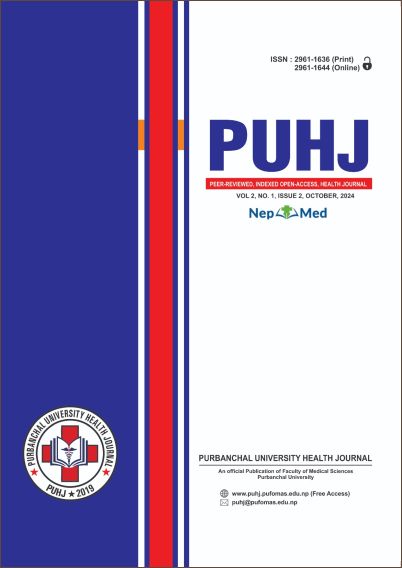Nutritional Status among Elderly People of Biratnagar, Nepal
DOI:
https://doi.org/10.3126/puhj.v2i1.74945Keywords:
Aged, Humans, Nutritional status, NepalAbstract
Introduction: Globally, the population of older adults is growing. According to the World Health Organization, there will be 1.2 billion older people worldwide by 2025; with 840 million of them living in low-income nations. Age-related health is significantly influenced by nutrition. However, nutrition is not considered as a high priority for older adults and many older adults are forced to live in care facilities.
Objective: The objective of this research was to evaluate nutritional status and the factors affecting to it among elderly individuals living in an aged care facility in Biratnagar, Nepal.
Method: A cross-sectional study was conducted at an aged care fa¬cility in Biratnagar from March to November 2021, involving 50 el¬derly residents selected through total enumeration. Data collection utilized Nestle’s Mini Nutritional Assessment tool, a general assess¬ment questionnaire, and doctor’s prescriptions for outcome valida¬tion. Statistical analysis was performed using SPSS version 20, and ethical clearance was obtained from the Institutional Review Com¬mittee of Purbanchal University School of Health Sciences. Descrip¬tive and inferential statistics were employed for data analysis.
Result: Nearly half (48%) of the participants fell within the 60–69 age group, while 36% were aged between 70–79 years. Females con¬stituted the majority, accounting for 52% of the sample. Among the elderly, 20% exhibited normal nutritional status, while 70% were at risk of malnutrition, and 10% were identified as malnourished. Gen¬der was significantly associated with nutritional status, with male participants showing increased susceptibility to malnutrition with advancing age.
Conclusion: The prevalence of malnutrition and risk of malnutrition among the elderly in aged care homes was found to be considerable. Interventional studies should be undertaken by government agencies, nutritional organizations, and aged care homes to enhance the nutri-tional status of elderly individuals.
Downloads
Downloads
Published
How to Cite
Issue
Section
License
Copyright (c) 2024 The Author(s)

This work is licensed under a Creative Commons Attribution-NonCommercial 4.0 International License.
This license enables reusers to distribute, remix, adapt, and build upon the material in any medium or format for noncommercial purposes only, and only so long as attribution is given to the creator.




